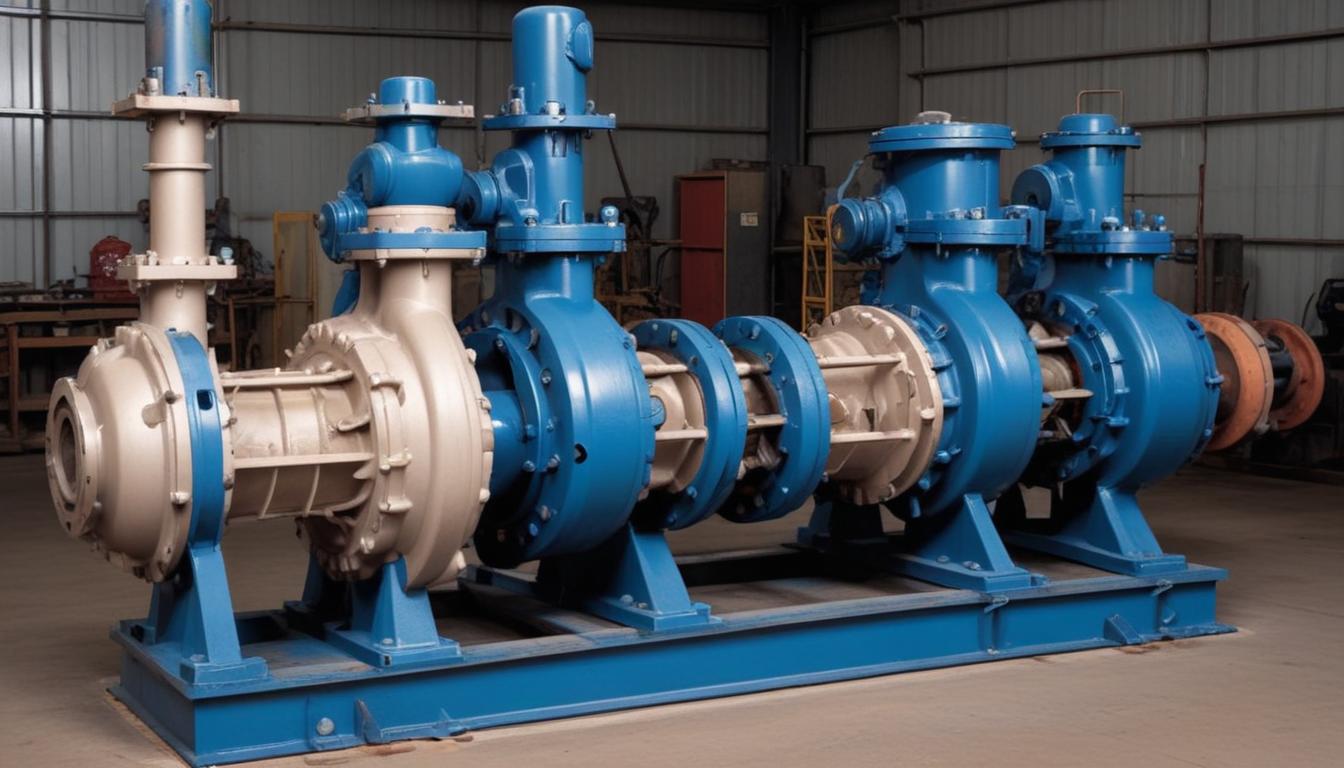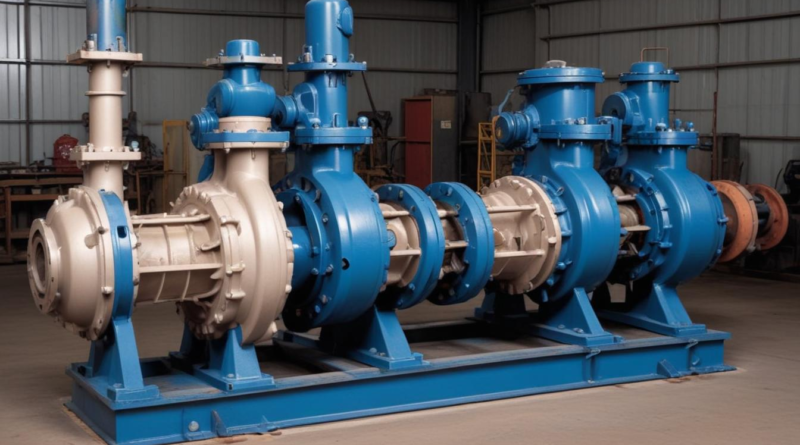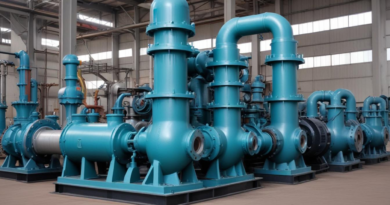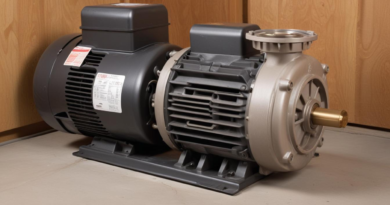how to handle pump vibration issues
Pump vibrations are oscillatory motions that occur within a pumping system, which can significantly impact the performance and longevity of the equipment. These vibrations can be categorized based on their sources and the nature of their occurrence. Understanding the fundamentals of pump vibration is essential for effective handling and the implementation of appropriate solutions.
Types of Pump Vibrations:
- Horizontal Shaft Vibrations: Occur in pumps with horizontal shafts and are typically associated with unbalanced loads or misalignments.
- Vertical Shaft Vibrations: Found in vertical pumps, these vibrations are often due to foundation issues or improper installation.
- Fluid-Induced Vibrations: Result from turbulent flow, cavitation, or resonance within the pump system.
- Mechanical Vibrations: Caused by faulty bearings, gear defects, or misaligned components.
Factors Influencing Pump Vibrations:
| Factor | Description |
|---|---|
| Rotation Speed | Higher speeds can increase vibration levels if not properly balanced. |
| Fluid Properties | Viscosity and density of the pumped fluid can affect vibration characteristics. |
| System Alignment | Misalignment between the pump and motor shafts leads to increased vibrations. |
| Foundation Integrity | A stable foundation minimizes the transmission and amplification of vibrations. |
Consequences of Unaddressed Pump Vibrations:
- Mechanical Wear: Continuous vibrations accelerate wear and tear on bearings, seals, and other components.
- Structural Damage: Persistent vibrations can cause cracks and weakening of structural elements.
- Operational Inefficiency: Vibration-induced energy losses reduce the overall efficiency of the pumping system.
- Safety Hazards: Severe vibrations may lead to catastrophic failures, posing risks to personnel and infrastructure.
Measurement and Analysis: Effective management of pump vibrations begins with accurate measurement and thorough analysis. Utilizing tools such as accelerometers and vibration analyzers helps in identifying vibration patterns and their root causes. By understanding the specific vibration modes and their impacts, engineers can design targeted strategies to mitigate adverse effects and enhance the reliability of the pumping system.
Common causes of vibration
Common Causes of Pump Vibration
Pump vibrations can stem from a variety of sources, each contributing differently to the overall oscillatory behavior within the system. Identifying these causes is crucial for effective handling and the implementation of appropriate solutions to mitigate adverse effects.
- Imbalance: An uneven distribution of mass in the pump’s rotating components, such as the impeller or shaft, can lead to significant vibrations. This imbalance causes centrifugal forces that disrupt the smooth operation of the pump.
- Misalignment: Improper alignment between the pump and its driving motor results in additional stresses and vibrations. Misalignment can be angular, parallel, or a combination of both, exacerbating wear on bearings and seals.
- Worn or Damaged Bearings: Bearings that have deteriorated due to wear, contamination, or improper lubrication can introduce irregular movements, increasing pump vibration levels. Faulty bearings often produce characteristic noise and erratic vibration patterns.
- Cavitation: The formation and collapse of vapor bubbles within the pump can generate intense shockwaves, leading to vibrations and potential physical damage to pump components. Cavitation is typically caused by insufficient inlet pressure or excessive flow rates.
- Resonance: When the natural frequency of the pump system coincides with the frequency of operational forces, resonance occurs, amplifying vibrations. This condition can lead to excessive movement and structural fatigue over time.
- Structural Issues: Weaknesses or flaws in the pump foundation or mounting structures can amplify vibrations. Poorly constructed or deteriorated foundations fail to dampen vibrational energy effectively.
- Fluid-Induced Vibrations: Turbulent flow, pulsations, and pressure fluctuations within the fluid being pumped can induce vibrations. These fluid dynamics-related vibrations are often influenced by the pump design and operating conditions.
- Gearbox Problems: In pumps equipped with gearboxes, issues such as gear tooth damage, backlash, or lubrication failures can create imbalances and vibrations. Gearbox-related vibrations typically exhibit distinct frequency signatures.
Detailed Overview of Common Causes:
| Cause | Description |
|---|---|
| Imbalance | Occurs when the rotating components have uneven mass distribution, leading to centrifugal forces that cause vibrations during operation. |
| Misalignment | Refers to the improper alignment of the pump and motor shafts, resulting in increased mechanical stress and vibration. |
| Worn Bearings | Bearings that have degraded over time can no longer support the shaft effectively, causing erratic movements and vibrations. |
| Cavitation | Formation of vapor bubbles in the fluid due to low pressure, leading to bubble collapse and resulting in shockwaves that induce vibrations. |
| Resonance | Condition where the system’s natural frequency matches the operational frequency, causing amplified vibrations. |
| Structural Issues | Weak or damaged pump foundations can fail to absorb vibrational energy, leading to increased vibration transmission. |
| Fluid-Induced Vibrations | Turbulent or pulsating flow within the pump can create fluctuating forces that result in vibrations. |
| Gearbox Problems | Issues within the gearbox, such as damaged gears or insufficient lubrication, can lead to vibration due to imbalanced gear operation. |
Understanding these common causes is the first step in diagnosing and addressing pump vibrations. By systematically evaluating each potential source, maintenance teams can implement targeted solutions to enhance pump performance and extend the equipment’s operational lifespan.
Detecting and measuring vibrations
Accurate detection and measurement of pump vibrations are critical for effective handling of vibration-related issues. Implementing systematic monitoring ensures early identification of potential problems, allowing for timely interventions and minimizing downtime.
Techniques for Detecting Pump Vibrations:
- Visual Inspections: Regular visual examinations of the pump and its components can reveal signs of excessive wear, misalignment, or structural damage caused by vibrations.
- Acoustic Monitoring: Utilizing microphones and acoustic sensors to capture sound emissions from the pump can help identify abnormal noise patterns indicative of underlying vibration issues.
- Thermography: Infrared cameras detect temperature anomalies in bearings and other critical components, which may result from friction caused by vibrations.
Measurement Tools and Equipment:
- Accelerometers: These devices measure the acceleration of vibrations in multiple axes, providing detailed information about the vibration intensity and frequency.
- Vibration Analyzers: Portable or stationary analyzers process data from accelerometers to display vibration spectra, helping in the identification of specific vibration signatures.
- Displacement Sensors: These sensors measure the movement or displacement of pump components, offering insights into the amplitude of vibrations.
- Data Acquisition Systems: Integrated systems collect and store vibration data over time, facilitating trend analysis and long-term monitoring.
Key Parameters to Monitor:
| Parameter | Description |
|---|---|
| Vibration Amplitude | Represents the magnitude of the vibration, typically measured in units such as millimeters per second (mm/s) or feet per minute (fpm). |
| Frequency | Indicates the rate at which vibrations occur, measured in Hertz (Hz). Different frequencies can be associated with specific mechanical issues. |
| Velocity | Measures the speed of the vibration movement, providing another dimension of vibration intensity. |
| Phase Angle | Describes the relationship between different vibration signals, which can help in identifying misalignment or imbalance. |
Steps for Effective Vibration Measurement:
- Establish Baselines: Determine the normal vibration levels under standard operating conditions to identify deviations over time.
- Select Appropriate Measurement Points: Identify critical locations on the pump and its mounting structures where vibrations are likely to be most pronounced.
- Calibrate Equipment: Ensure that all measurement tools are properly calibrated to provide accurate and reliable data.
- Conduct Regular Monitoring: Implement a routine schedule for vibration measurements to continuously assess the pump’s condition.
- Analyze Data: Use specialized software to interpret vibration data, identifying trends and correlating them with potential mechanical issues.
- Report Findings: Document and communicate the results of vibration measurements to stakeholders for informed decision-making regarding maintenance and repairs.
Advanced Measurement Techniques:
- Modal Analysis: Determines the natural frequencies and mode shapes of the pump system, helping to identify resonance conditions that can amplify vibrations.
- Time Waveform Analysis: Examines the vibration signal in the time domain to detect transient events such as impacts or sudden changes in vibration patterns.
- FFT (Fast Fourier Transform) Analysis: Converts time-domain vibration data into the frequency domain, allowing for the identification of specific frequency components associated with various mechanical issues.
Implementing a comprehensive vibration detection and measurement strategy is essential for maintaining the integrity and performance of pumping systems. By leveraging advanced tools and methodologies, operators can proactively address pump vibrations, ensuring sustained operational efficiency and extending the lifespan of critical equipment.
Methods to reduce vibration
 Reducing vibrations in pumping systems involves a combination of targeted strategies designed to address the root causes and mitigate their effects. Implementing these solutions not only enhances the operational efficiency of the pump but also extends its lifespan and ensures reliable performance.
Reducing vibrations in pumping systems involves a combination of targeted strategies designed to address the root causes and mitigate their effects. Implementing these solutions not only enhances the operational efficiency of the pump but also extends its lifespan and ensures reliable performance.
Balancing Rotating Components:
- Rotor Balancing: Ensuring that the pump’s rotating parts, such as the impeller and shaft, are evenly balanced minimizes centrifugal forces that cause vibrations. This can be achieved through precision machining and the removal of excess material from unbalanced areas.
- Dynamic Balancing: Utilizing dynamic balancing machines to measure and correct imbalances in real-time during the operation of the pump helps in maintaining optimal performance.
Alignment of Pump and Motor:
- Proper Shaft Alignment: Misalignment between the pump and motor shafts is a common source of vibrations. Techniques such as laser alignment and dial indicators should be employed to ensure precise alignment, thereby reducing mechanical stress and vibration levels.
- Flexible Couplings: Installing flexible couplings can absorb minor misalignments and compensate for thermal expansions, reducing the transmission of vibrations from the motor to the pump.
Vibration Isolation:
- Mounting Bases: Using vibration isolators or resilient mounts between the pump and its foundation dampens vibrational energy, preventing it from propagating to surrounding structures.
- Shock Absorbers: Incorporating shock absorbers in the mounting system can further mitigate the impact of transient vibrations caused by sudden changes in pump operation.
Securing and Stabilizing Structures:
- Foundation Strengthening: Enhancing the stability and rigidity of the pump foundation reduces the amplification of vibrations. Techniques include using concrete pads with appropriate reinforcement and ensuring the foundation is level and free from cracks.
- Piping Supports: Properly securing piping with anchors, clamps, and flexible joints prevents the transmission of vibrations through the piping network, thereby isolating the pump from the rest of the system.
Reducing Fluid-Induced Vibrations:
- Flow Control: Adjusting the pump’s operating conditions, such as flow rate and pressure, to avoid turbulent flow and cavitation minimizes fluid-induced vibrations.
- Impeller Design: Selecting or redesigning impellers to ensure smooth fluid flow reduces the likelihood of vortices and pressure fluctuations that contribute to vibrations.
Advanced Dampening Techniques:
- Tuned Mass Dampers: Installing mass dampers tuned to specific frequencies can absorb and dissipate vibrational energy, effectively reducing resonance and overall vibration levels.
- Active Vibration Control: Implementing active control systems that use sensors and actuators to counteract vibrations in real-time provides a sophisticated solution for maintaining low vibration levels.
Operational Adjustments:
- Speed Optimization: Operating the pump at speeds that avoid resonance frequencies prevents the amplification of vibrations. Variable frequency drives (VFDs) can be used to adjust pump speed dynamically based on operating conditions.
- Load Balancing: Ensuring that the pump operates within its designed load range prevents overloading, which can induce excessive vibrations.
Regular Maintenance and Inspection:
- Routine Checks: Conducting regular maintenance activities, such as inspecting bearings, seals, and coupling integrity, ensures that all components are in good condition and functioning correctly, thereby preventing vibration issues.
- Predictive Maintenance: Utilizing condition monitoring tools to predict potential failures allows for timely interventions before vibrations escalate into major problems.
Implementation of a Comprehensive Vibration Reduction Plan:
| Solution | Description |
|---|---|
| Balancing | Corrects uneven mass distribution in rotating components to minimize centrifugal forces and reduce vibrations. |
| Alignment | Ensures precise alignment of pump and motor shafts to prevent mechanical stress and vibration transmission. |
| Isolation | Uses mounts and dampers to absorb and mitigate vibrational energy from the pump and motor. |
| Flow Control | Adjusts operating conditions to maintain smooth fluid flow and prevent cavitation-induced vibrations. |
| Dampening Techniques | Employs mass and active dampers to absorb vibrational energy and reduce resonance effects. |
Implementing these methods requires a thorough understanding of the specific pumping system and its operational parameters. By adopting a multifaceted approach to vibration reduction, facilities can effectively handle pump vibrations, ensuring sustained performance and minimizing the risk of mechanical failures.
Maintenance and monitoring practices
Effective maintenance and monitoring practices are critical for minimizing pump vibrations and ensuring the longevity and reliability of the pumping system. Implementing a structured maintenance program helps in early detection of potential issues and facilitates timely interventions, thereby reducing downtime and preventing costly repairs.
Regular Maintenance Tasks:
- Lubrication: Consistently lubricating bearings and moving parts reduces friction and wear, which are common sources of pump vibration. Using the correct type and amount of lubricant is essential for optimal performance.
- Shaft Alignment Checks: Periodically verifying the alignment between the pump and motor shafts ensures that misalignment does not develop over time, preventing increased vibrations and mechanical stress.
- Balancing Rotating Components: Regularly balancing the impeller and other rotating parts eliminates uneven mass distribution, which is a primary cause of centrifugal forces leading to vibrations.
- Inspecting Bearings and Seals: Routine inspection of bearings and seals for signs of wear, corrosion, or damage helps in identifying issues before they escalate into significant vibration problems.
- Monitoring Wear and Tear: Assessing the condition of pump components, such as the casing, impeller, and couplings, for any signs of deterioration ensures that necessary repairs or replacements are performed promptly.
Monitoring Practices:
- Vibration Monitoring Systems: Installing continuous vibration monitoring systems enables real-time tracking of vibration levels, allowing for immediate detection of abnormal behavior.
- Scheduled Inspections: Conducting regular inspections based on a predefined schedule ensures that all critical components are evaluated consistently, maintaining the pump’s operational integrity.
- Predictive Maintenance: Utilizing data from vibration analyzers and other condition monitoring tools to predict potential failures before they occur helps in planning maintenance activities proactively.
- Condition Monitoring Tools: Employing advanced tools such as accelerometers, vibration analyzers, and thermographic cameras provides comprehensive insights into the pump’s condition, facilitating accurate diagnosis of vibration issues.
Maintenance Strategies:
| Strategy | Description |
|---|---|
| Preventive Maintenance | Involves regular, scheduled maintenance activities aimed at preventing unexpected failures and minimizing pump vibrations through routine checks and servicing. |
| Predictive Maintenance | Relies on real-time data and condition monitoring to predict when maintenance should be performed, ensuring interventions are made before vibrations lead to significant damage. |
Documentation and Records:
- Maintenance Logs: Keeping detailed records of all maintenance activities, inspections, and repairs provides a historical reference that can be used to identify patterns and recurring issues related to pump vibrations.
- Vibration Data Records: Storing vibration measurement data over time allows for trend analysis, helping to track the effectiveness of maintenance actions and the overall health of the pump system.
- Reporting Systems: Implementing standardized reporting systems ensures that all relevant information is communicated effectively to maintenance teams and management, facilitating informed decision-making.
Best Practices:
- Training Personnel: Providing comprehensive training for maintenance staff on vibration analysis, pump mechanics, and best maintenance practices ensures that they are equipped to handle pump vibration issues effectively.
- Standard Operating Procedures (SOPs): Developing and adhering to SOPs for maintenance and monitoring activities ensures consistency and reliability in handling pump vibrations.
- Continuous Improvement: Regularly reviewing and updating maintenance practices based on the latest industry standards and technological advancements helps in optimizing vibration handling solutions.
Implementation of a Comprehensive Maintenance and Monitoring Plan:
| Aspect | Action |
|---|---|
| Routine Maintenance | Schedule regular lubrication, alignment checks, and inspections to maintain pump balance and component integrity. |
| Advanced Monitoring | Integrate continuous vibration monitoring systems and predictive maintenance tools to identify and address issues proactively. |
| Data Management | Maintain accurate records of all maintenance activities and vibration measurements to support trend analysis and informed decision-making. |
| Staff Training | Ensure maintenance personnel are trained in the latest vibration detection and handling techniques to effectively implement solutions. |
| Review and Optimization | Regularly assess the effectiveness of maintenance and monitoring practices, making adjustments as necessary to enhance pump performance and reduce vibrations. |
By adhering to these maintenance and monitoring practices, facilities can effectively manage pump vibrations, ensuring the smooth and efficient operation of their pumping systems. Proactive maintenance not only addresses current vibration issues but also prevents future problems, thereby extending the lifespan of pump equipment and reducing operational costs.




